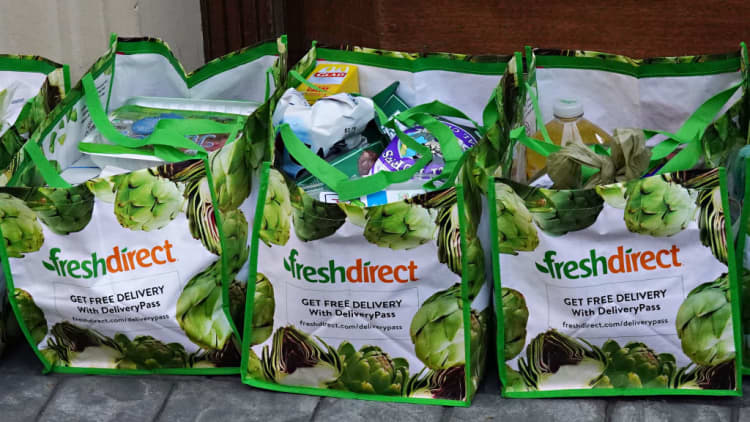For some American shoppers and grocers, it took a pandemic to push them online.
As the coronavirus spread in the spring, some customers downloaded grocery shopping apps for the first time and bought more groceries than usual through e-commerce rather than in stores.
That translated to a larger share of grocery shopping moving online. U.S. online shopping accounted for 5.1% of grocery sales at the end of 2019 and rose to 6.6% as of April 12, according to a Bain & Co. report released Thursday. The report said it also increased in places including United Kingdom, France and Italy.
The trend has laid bare an unpleasant reality for grocers: As they sell more online, their profits are squeezed. Shifting consumer behavior caused by the coronavirus pandemic has created new urgency for grocers to fix the broken business model, particularly if there's a second wave of infections, Bain said.
"In some sense, it's a wake-up call," said Steve Caine, one of the report's authors. "You can't just run it at a loss. You can't ignore the fundamental economic equation any longer. You've got to begin experimenting, particularly with the revenue model, to get to a path towards sustainability."
Online grocery shopping has gotten new attention as consumers use the approach to reduce risk during the pandemic. Many grocers already have a mix of online offerings. Walmart delivers to the home and offers curbside pickup of online orders. Target customers can buy online and retrieve their purchases in stores, by drive-up or through Target-owned home delivery service Shipt. And Kroger and other grocers have used third-party companies like Instacart to pick and deliver groceries.
They're investing in new ways, too. Target is adding hundreds of fresh and frozen items to its same-day online grocery shopping assortment. Kroger is building high-tech facilities across the U.S. with British robotics company Ocado to help fulfill online grocery orders. Its first facility is expected to open in 2021 in a Cincinnati suburb.
Grocery shopping rose across the board — in stores and online — as Americans cooked more at home and restaurants temporarily shut during stay-at-home orders. Some e-commerce numbers have been eye-popping. Walmart's e-commerce shot up by 74% in the first quarter, with much of that fueled by groceries. Kroger, the country's largest supermarket chain, saw a 92% jump in its first quarter.
But analysts and investors have questioned whether that represents a true shift or a coronavirus-related blip that will fade away as Americans opt to pick out their own produce and browse store aisles again.
Bain's report says the course of the pandemic will help determine that. It plays out three possible scenarios for Covid-19.
If there is a second wave this year, a reinstatement of restrictions and a vaccine isn't ready until mid-2021 after 18 months of development, consumers will be more likely to stick with or return to online grocery shopping, the report said. It projected that online grocery penetration would jump to nearly 14% in the United Kingdom, 13% in France and 11% in the U.S. in the next five years — about 1.5 times or more the pre-Covid forecast.
The more middle-of-the road scenario anticipates growth in online grocery penetration would be elevated but more modest. It's based on countries emerging from restrictions in stable condition, a vaccine arriving within 12 to 14 months and grocers keeping up with demand and stepping up customer experience.
In the lowest growth scenario, Bain projects customers will return to more traditional grocery shopping. In that situation, the virus would be well-managed, restrictions would fade quickly, there would be a vaccine within 12 months and customers would face some struggles, such as shortages of grocery items.
Regardless of the scenario, the report said, the pandemic resembles "someone pressing the fast-forward button on the industry by several years." That puts grocers on a clock to figure out their business model, it says.
Grocery stores already have notoriously low margins. With online grocery shopping, they get even thinner as grocers take on tasks like picking and transporting items — yet reluctant to charge for that extra work.
For example, in-store grocery sales tend to have an operating margin of 2% to 4%, according to Bain. That drops to -5% for a grocer that picks from a store and has a customer retrieve the order through click-and-collect. It drops even further to -15% if a grocer picks from a store and delivers to the customers' home.
The report said grocers must shake off their fear of fees, embrace automation and make money in new ways. The authors of the Bain report said solutions include investing in large automated fulfillment centers, vending machine-like micro-fulfillment centers in the back of stores and converting money-losing stores into "dark stores."
And they say grocers should look to creative new revenue streams. That could include selling banner ads on their website or app to companies that want to promote a grocery item, allowing brands to pay to add a free sample to customers' online baskets and charging for insights gleaned from virtual shoppers.
Online grocery sales may be a money-losing venture, Caine said, but there is a silver lining. He said grocers have picked up new customers because of having the services during the pandemic. Plus, he said, by taking advantage of density and volume, grocers can ultimately become more efficient and profitable.
"There's a little bit of a 'you have to build it and they will come' and the flywheel can begin to take over," he said.



